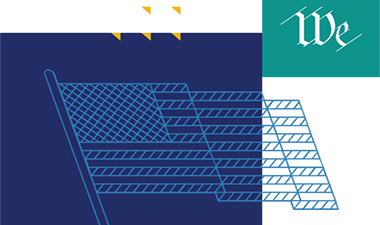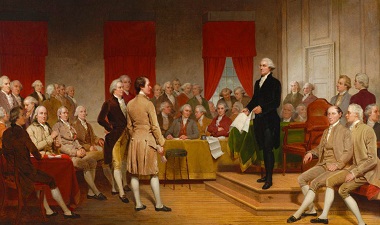In this module, students begin by taking a closer look at the Constitution and exploring how citizens, scholars, lawyers, and judges engage in civil dialogue. As they explore the text, students will learn the difference between constitutional questions and political questions and explore different methods of interpreting the Constitution. Throughout the module, students will also be practicing important skills including analyzing primary sources and asking and answering questions.
Curriculum – Get Started!Teacher-Led
Constitution 101 Curriculum for Middle School

Overview
This course is a set of 15 flexible modules that will lead middle schoolers through the process of inquiry to build their own understanding of the Constitution. By exploring the Constitution’s history and creation, its unique structure, and pivotal case law, students will study the historical and philosophical foundations of America’s founding principles throughout history.
Learn more about the course from Lucy, your student's new animated guide to constitutional learning.
Available for Google Classroom or PDF printed handouts, each module in the curriculum is guided by two documents, a Teacher Guide and a Student Content Guide, that provide the support you need to effectively engage students with the topics and activities. Every module is filled with materials that inspire student engagement. See what’s inside below, and explore each component further in the Course Guide.
Each module includes opportunities for guided discovery and practice through the following components:
- Key questions to drive inquiry
- Activate prior knowledge ideas to build connections
- Vocabulary supports to scaffold learning
- Unboxing the Constitution videos to increase engagement with constitutional topics
- Inside the Constitution videos to break down constitutional topics with the NCC’s President and CEO Jeffrey Rosen
- Student activities to encourage individual and collaborative learning
- Civic connections and learning projects to deepen knowledge
Materials
Teacher Guide
Created in collaboration with middle school teachers from across the country, each module-specific guide highlights overall goals, provides insights into how you can scaffold and adapt lesson activities, and shares insights to further support implementation. You can also explore a course-wide teacher's guide that shares insight into overall goals and universal methods for application.
Student Content Guide
The student content guide is a content-focused resource that can be shared directly with students so they engage with the material on their own, or adapted for your preferred method of content sharing. This material complements the activities, primary sources, and videos included in each module.
Modules
In this module, students will learn about the people and ideas that inspired the founders to envision a better way forward. As they explore and analyze primary sources like the Declaration of Independence, students will begin to recognize the key principles that are the foundation of the new government. They will also identify the reasons leading to the American Revolution. Throughout the module, students will practice important skills like analyzing primary sources and asking and answering questions.
Curriculum – Get Started!In this module, students will learn about the early national government established by the Articles of Confederation and about the state constitutions written before the U.S. Constitution. Students will explore what life was like for Americans after the Declaration of Independence and figure out why some Americans chose to participate in mob violence. They will also analyze important primary sources to uncover why the founders wanted to create a new constitution.
Curriculum – Get Started!In this module, students will learn more about the Constitutional Convention. Students will learn more about the delegates who attended the Convention and explore their opinions on important issues that needed to be decided. They will discuss what it means to come to a compromise through debate, and how compromising helped achieve ratification. Finally, students will learn about the views of Federalists and Anti-Federalists and analyze primary sources to help you better understand the different points of view.
Curriculum – Get Started!In this module, students will learn about the Bill of Rights, the first 10 amendments to the Constitution. The Bill of Rights guarantees important rights to Americans, including freedom of speech, freedom of religion, and protection from unreasonable searches. As students explore the text, they will learn why the idea of a Bill of Rights had a big influence on ratifying the Constitution.
Curriculum – Get Started!In this module, students will learn how the founders divided the powers given to the federal government by designing three different branches of the government. As students explore primary sources, they will uncover why this separation of powers was important. Students will also learn more about how power was divided between the federal government and state governments in a system called federalism.
Curriculum – Get Started!In this module, students will learn more about the legislative branch by exploring the powers and limits of Congress outlined in the Constitution. Students will uncover how the Constitution grants Congress the power to make laws and spells out the structure and functions of the legislative branch. They will also have the opportunity to learn how several Supreme Court cases shaped the way Congressional powers and limits were defined over time.
Curriculum – Get Started!In this module, students will uncover how Article II of the Constitution establishes the executive branch of the national government, headed by a single President. The President’s primary responsibility is to carry out the executive branch’s core function—namely, enforcing the nation’s laws. Students will look at sections of Article II that outline the method for electing the President, the scope of the President’s powers and duties, and the process of removing one from office. They will also explore how the Supreme Court and Congress have shaped the role of the Presidency over time.
Curriculum – Get Started!In this module, students will uncover how Article III of the Constitution establishes the judicial branch of the federal government, which is responsible for interpreting laws. Students will explore the structure of the judicial branch, led by the United States Supreme Court, and learn how Supreme Court justices are selected. They will also explore two key concepts that are part of the nation’s system of checks and balances: judicial independence and judicial review.
Curriculum – Get Started!In this module, students will begin to take a closer look at the freedoms granted in the First Amendment to the Constitution. The First Amendment protects five freedoms: religion, speech, press, assembly, and petition. Students will learn how these First Amendment rights protect the freedom to think and speak their own mind. They will also explore debates over the First Amendment’s five freedoms, examine several landmark Supreme Court cases, and investigate how the First Amendment has been used by groups of all perspectives to promote their vision of a more perfect Union.
Curriculum – Get Started!In this module, students will begin to take a closer look at the protections provided by the Fourth Amendment. The Fourth Amendment establishes that individuals have the right to be secure against unreasonable searches and seizures of our bodies, homes, papers, and belongings. This amendment plays a crucial role in shaping our interactions with law enforcement.
Curriculum – Get Started!In this module, students will learn how slavery was already a big part of life in America by the time the Constitution was written and how during the Constitutional Convention, delegates made compromises that protected the interests of slaveholders. They will also explore how in the years that followed debates over slavery grew more intense, leading to Abraham Lincoln’s election as the first anti-slavery president, the South’s decision to break away from the U.S., and the Civil War. Students will also explore America’s “Second Founding,” the period after the war, when leaders worked to rebuild the country and strengthen the Constitution by passing the nation’s first civil rights laws and adding the 13th, 14th, and 15th Amendments to the Constitution.
Curriculum – Get Started!In this module, students will look closely at how voting rights have changed over time, including through amendments to the Constitution that have expanded the right. They will learn how the original Constitution did not specifically protect the right to vote—leaving the issue largely to the states. Students will also explore how new amendments granted Congress new power to enforce these rights. Finally, they will look at the roles played by the federal government and the powers of the individual states to play a central role in elections today.
Curriculum – Get Started!In this module, students will explore the 14th Amendment, which defines citizenship, guarantees equal protection of the laws, protects people from unfair actions by state and federal governments, and was key in extending the protections of the Bill of Rights to the states. Students will learn about the text, history, and application of the 14th Amendment and explore how the amendment has been instrumental in expanding freedom and equality in the United States since its ratification.
Curriculum – Get Started!In this module, students will look closely at Article V of the Constitution, which explains the process for changing, or amending, the Constitution. Students will explore the amendment process to make big changes to the Constitution from the very beginning. Students will explore the amendment process, look at the reasons why the Founders chose to include a way to change the Constitution, and survey all 27 amendments to the Constitution.
Curriculum – Get Started!Find More Classroom Resources
Search our library by grade level, topics or resource type to find more lesson plans, videos, and interactives.








